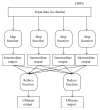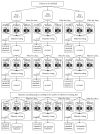Parallelizing Backpropagation Neural Network Using MapReduce and Cascading Model
- PMID: 27217823
- PMCID: PMC4863083
- DOI: 10.1155/2016/2842780
Parallelizing Backpropagation Neural Network Using MapReduce and Cascading Model
Abstract
Artificial Neural Network (ANN) is a widely used algorithm in pattern recognition, classification, and prediction fields. Among a number of neural networks, backpropagation neural network (BPNN) has become the most famous one due to its remarkable function approximation ability. However, a standard BPNN frequently employs a large number of sum and sigmoid calculations, which may result in low efficiency in dealing with large volume of data. Therefore to parallelize BPNN using distributed computing technologies is an effective way to improve the algorithm performance in terms of efficiency. However, traditional parallelization may lead to accuracy loss. Although several complements have been done, it is still difficult to find out a compromise between efficiency and precision. This paper presents a parallelized BPNN based on MapReduce computing model which supplies advanced features including fault tolerance, data replication, and load balancing. And also to improve the algorithm performance in terms of precision, this paper creates a cascading model based classification approach, which helps to refine the classification results. The experimental results indicate that the presented parallelized BPNN is able to offer high efficiency whilst maintaining excellent precision in enabling large-scale machine learning.
Figures











References
-
- Big Data, A New World of Opportunities. Networked European Software and Services Initiative (NESSI) White Paper, 2012, http://www.nessi-europe.com/Files/Private/NESSI_WhitePaper_BigData.pdf.
-
- Hagan M. H., Demuth H. B., Beale M. H. Neural Network Design. PWS Publishing Company; 1996.
-
- Dean J., Ghemawat S. MapReduce: simplified data processing on large clusters. Communications of the ACM. 2008;51(1):107–113. doi: 10.1145/1327452.1327492. - DOI
-
- Almaadeed N., Aggoun A., Amira A. Speaker identification using multimodal neural networks and wavelet analysis. IET Biometrics. 2015;4(1):18–28. doi: 10.1049/iet-bmt.2014.0011. - DOI
-
- Chen A., Ye J. Research on four-layer back propagation neural network for the computation of ship resistance. Proceedings of the IEEE International Conference on Mechatronics and Automation (ICMA '09); August 2009; Changchun, China. IEEE; pp. 2537–2541. - DOI
MeSH terms
LinkOut - more resources
Full Text Sources
Other Literature Sources

